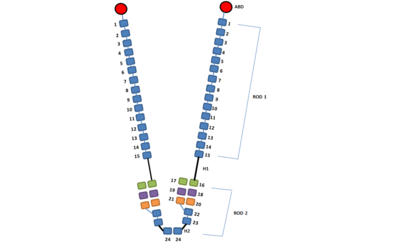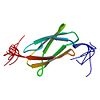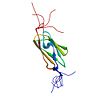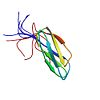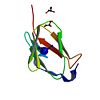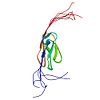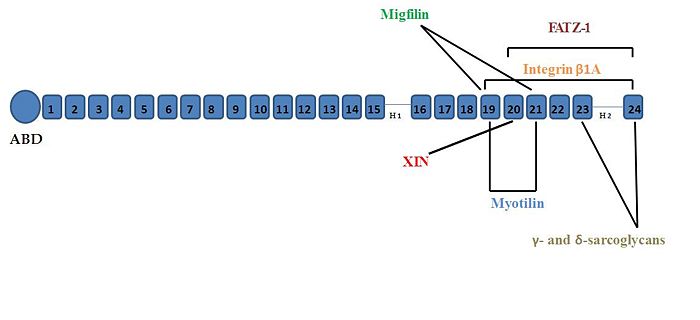Group:MUZIC:FilaminC
From Proteopedia

Contents |
Filamin C
In humans, 3 isoforms of Filamins exist that are coded by 3 different genes. While the genes for Filamin A and Filamin B are present on the X chromosome and chromosome 3 respectively, and both show a ubiquitous expression in many tissues, gene for Filamin C is located on the Chromosome 7 and the encoded protein is specifically expressed in muscles and has been predicted to have a Z disc targeting motif. [1]
Filamin C (also known as FLNc/Gamma-Filamin/ ABPL) is an actin binding homodimeric protein composed of two 290 kDa subunits. Each subunit is composed of an α-actinin like N terminal actin binding domain (ABD) made up of 2 calponin homology tandem repeats followed by a flexible rod region containing 24 Immunoglobulin like domains (Ig- like) of around 96 residues each. Each Ig domain is made of 7 β strands arranged antiparallel in group of 4 and 3 sheets forming a β sandwich. The most C terminal domain (Ig 24) is the self association domain required for its dimerization ability. (Shown on right) The presence of 2 flexible calpain sensitive hinges, Hinge 1 between domain 15 and 16 divides the subunit into Rod 1 and Rod 2 domains and Hinge 2 between 23 and 24 separates the dimerization domain from the rest of domains. It is noteworthy to mention that the Hinge 1 is alternatively spliced and the majorly expressed variant of FLNc in striated muscles, lacks this hinge [2]. Also, in FLNc, there is a unique insertion of 80 amino acid residues in domain 20, which is predicted to play a role in Z disc targeting. [3] As the three Filamin proteins share around 70% homology over the entire sequence with the exception of the hinges [4], not many structures of the Filamin C domains exist in the PDB.
Sequence
The amino-acid sequence of Human Filamin C is available from uniprot uniprot. The sequence annotation based on the tertiary structure is provided in Figure 1. Note that in Filamin C, Hinge 1 is absent. Also, the evidence for the presence of domain pairs in the C terminal region is only confirmed for FLNa and FLNb. [5] [6] [7]
3D Structures
So far, only 7 3 dimensional structures of Filamin C domains exist in the protein database, out which only 2 are solved by X ray crystallography and the rest are solved by NMR.
2d7m - This is a solution structure of the 14th Filamin domain from human Filamin C solved by Solution NMR
2d7n - This is a solution structure of the 16th Filamin domain from human Filamin C solved by Solution NMR
2d7o - This is a solution structure of the 17th Filamin domain from human Filamin C solved by Solution NMR
2d7p - This is a solution structure of the 22th Filamin domain from human Filamin C solved by Solution NMR
2nqc - This is a structure of Ig-like domain 23 from human filamin C solved by X ray Crystallography
2d7q - This is a solution structure of the 23th Filamin domain from human Filamin C solved by Solution NMR
1v05 - This is a structure of the Domain 24 (Dimerization domain) of human Filamin C solved by X ray Crystallography
Functions and interaction partners of Filamin C
Since its discovery in 1975 as one of the most potent crosslinkers of F- actin [8] , major efforts have been focused to elucidate the role of Filamins as scaffolding and signaling molecule in cells.
Its major functions include:
• Cross linking actin filaments to form Orthogonal branched networks
• Physically linking actin cytoskeleton to the membrane
• Localization of the membrane receptors and stabilization of the membrane
• Serving as scaffold for various interacting proteins which indicates its role in signalling
Some of the major interacting partners are shown in the diagram here. [9]
• Integrin β1A - Domain 19-24 [10]
• Migfilin - Domain 21 [11] [12]
• FATZ-1 (myozenin-1, calsarcin 2) - Domain 20-24 [13]
• Gamma- and delta-sarcoglycans - Domain 23-24 [15]
• Myopodin - Domain 19-21 [16]
Pathology
Mutations in Filamin C gene form a rare cause Myofibrillar Myopathy (MFM) presenting a wide spectrum of clinical symptoms, mostly involving progressive muscle weakness in all limbs.
• First mutation identified in FLNc was in Ig domain 24 (Dimerization domain), caused by a non sense mutation of (8130G-->A; W2710X) [17]
• Recently an in frame 6 amino acid deletion (Lys899-Val904) and 2 amino acid insertion (Val 899-Cys900) was identified in Ig domain 7 [18]
• And another in frame 4 amino acid (Val930_Thr933) deletion mutation in Ig domain 7 has been found. [19]
• Recently a mutation of 7256C--->T (Thr2419Met) in exon 44 of FLNC coding for domain 22, has been linked to cerebral ataxia in some cases of MFM. [20]
• A mutation of 577G---->A (Ala193Thr)in the Filamin C ABD has been shown to cause dominant distal myopathy [21]
For an extended pathophysiology of the MFM, see [22] [23]
References
- ↑ 1.0 1.1 van der Ven PF, Wiesner S, Salmikangas P, Auerbach D, Himmel M, Kempa S, Hayess K, Pacholsky D, Taivainen A, Schroder R, Carpen O, Furst DO. Indications for a novel muscular dystrophy pathway. gamma-filamin, the muscle-specific filamin isoform, interacts with myotilin. J Cell Biol. 2000 Oct 16;151(2):235-48. PMID:11038172
- ↑ Xie Z, Xu W, Davie EW, Chung DW. Molecular cloning of human ABPL, an actin-binding protein homologue. Biochem Biophys Res Commun. 1998 Oct 29;251(3):914-9. PMID:9791010
- ↑ van der Ven PF, Ehler E, Vakeel P, Eulitz S, Schenk JA, Milting H, Micheel B, Furst DO. Unusual splicing events result in distinct Xin isoforms that associate differentially with filamin c and Mena/VASP. Exp Cell Res. 2006 Jul 1;312(11):2154-67. Epub 2006 Apr 24. PMID:16631741 doi:S0014-4827(06)00110-8
- ↑ van der Flier A, Sonnenberg A. Structural and functional aspects of filamins. Biochim Biophys Acta. 2001 Apr 23;1538(2-3):99-117. PMID:11336782
- ↑ Pentikainen U, Ylanne J. The regulation mechanism for the auto-inhibition of binding of human filamin A to integrin. J Mol Biol. 2009 Oct 30;393(3):644-57. Epub 2009 Aug 20. PMID:19699211 doi:10.1016/j.jmb.2009.08.035
- ↑ Heikkinen OK, Ruskamo S, Konarev PV, Svergun DI, Iivanainen T, Heikkinen SM, Permi P, Koskela H, Kilpelainen I, Ylanne J. Atomic structures of two novel immunoglobulin-like domain pairs in the actin cross-linking protein filamin. J Biol Chem. 2009 Sep 11;284(37):25450-8. Epub 2009 Jul 21. PMID:19622754 doi:10.1074/jbc.M109.019661
- ↑ Pentikainen U, Jiang P, Takala H, Ruskamo S, Campbell ID, Ylanne J. Assembly of a filamin four-domain fragment and the influence of splicing variant-1 on the structure. J Biol Chem. 2011 Jul 29;286(30):26921-30. Epub 2011 Jun 2. PMID:21636571 doi:10.1074/jbc.M110.195958
- ↑ Hartwig JH, Stossel TP. Isolation and properties of actin, myosin, and a new actinbinding protein in rabbit alveolar macrophages. J Biol Chem. 1975 Jul 25;250(14):5696-705. PMID:124734
- ↑ Furst DO, Goldfarb LG, Kley RA, Vorgerd M, Olive M, van der Ven PF. Filamin C-related myopathies: pathology and mechanisms. Acta Neuropathol. 2012 Oct 30. PMID:23109048 doi:10.1007/s00401-012-1054-9
- ↑ Gontier Y, Taivainen A, Fontao L, Sonnenberg A, van der Flier A, Carpen O, Faulkner G, Borradori L. The Z-disc proteins myotilin and FATZ-1 interact with each other and are connected to the sarcolemma via muscle-specific filamins. J Cell Sci. 2005 Aug 15;118(Pt 16):3739-49. Epub 2005 Aug 2. PMID:16076904 doi:10.1242/jcs.02484
- ↑ Lad Y, Jiang P, Ruskamo S, Harburger DS, Ylanne J, Campbell ID, Calderwood DA. Structural basis of the migfilin-filamin interaction and competition with integrin beta tails. J Biol Chem. 2008 Dec 12;283(50):35154-63. Epub 2008 Sep 30. PMID:18829455 doi:10.1074/jbc.M802592200
- ↑ Ithychanda SS, Das M, Ma YQ, Ding K, Wang X, Gupta S, Wu C, Plow EF, Qin J. Migfilin, a molecular switch in regulation of integrin activation. J Biol Chem. 2009 Feb 13;284(7):4713-22. doi: 10.1074/jbc.M807719200. Epub 2008, Dec 13. PMID:19074766 doi:10.1074/jbc.M807719200
- ↑ Gontier Y, Taivainen A, Fontao L, Sonnenberg A, van der Flier A, Carpen O, Faulkner G, Borradori L. The Z-disc proteins myotilin and FATZ-1 interact with each other and are connected to the sarcolemma via muscle-specific filamins. J Cell Sci. 2005 Aug 15;118(Pt 16):3739-49. Epub 2005 Aug 2. PMID:16076904 doi:10.1242/jcs.02484
- ↑ van der Ven PF, Ehler E, Vakeel P, Eulitz S, Schenk JA, Milting H, Micheel B, Furst DO. Unusual splicing events result in distinct Xin isoforms that associate differentially with filamin c and Mena/VASP. Exp Cell Res. 2006 Jul 1;312(11):2154-67. Epub 2006 Apr 24. PMID:16631741 doi:S0014-4827(06)00110-8
- ↑ Thompson TG, Chan YM, Hack AA, Brosius M, Rajala M, Lidov HG, McNally EM, Watkins S, Kunkel LM. Filamin 2 (FLN2): A muscle-specific sarcoglycan interacting protein. J Cell Biol. 2000 Jan 10;148(1):115-26. PMID:10629222
- ↑ Linnemann A, van der Ven PF, Vakeel P, Albinus B, Simonis D, Bendas G, Schenk JA, Micheel B, Kley RA, Furst DO. The sarcomeric Z-disc component myopodin is a multiadapter protein that interacts with filamin and alpha-actinin. Eur J Cell Biol. 2010 Sep;89(9):681-92. Epub 2010 May 31. PMID:20554076 doi:10.1016/j.ejcb.2010.04.004
- ↑ Vorgerd M, van der Ven PF, Bruchertseifer V, Lowe T, Kley RA, Schroder R, Lochmuller H, Himmel M, Koehler K, Furst DO, Huebner A. A mutation in the dimerization domain of filamin c causes a novel type of autosomal dominant myofibrillar myopathy. Am J Hum Genet. 2005 Aug;77(2):297-304. Epub 2005 May 31. PMID:15929027 doi:10.1086/431959
- ↑ Luan X, Hong D, Zhang W, Wang Z, Yuan Y. A novel heterozygous deletion-insertion mutation (2695-2712 del/GTTTGT ins) in exon 18 of the filamin C gene causes filaminopathy in a large Chinese family. Neuromuscul Disord. 2010 Jun;20(6):390-6. Epub 2010 Apr 22. PMID:20417099 doi:10.1016/j.nmd.2010.03.009
- ↑ Shatunov A, Olive M, Odgerel Z, Stadelmann-Nessler C, Irlbacher K, van Landeghem F, Bayarsaikhan M, Lee HS, Goudeau B, Chinnery PF, Straub V, Hilton-Jones D, Damian MS, Kaminska A, Vicart P, Bushby K, Dalakas MC, Sambuughin N, Ferrer I, Goebel HH, Goldfarb LG. In-frame deletion in the seventh immunoglobulin-like repeat of filamin C in a family with myofibrillar myopathy. Eur J Hum Genet. 2009 May;17(5):656-63. Epub 2008 Dec 3. PMID:19050726 doi:10.1038/ejhg.2008.226
- ↑ Tasca G, Odgerel Z, Monforte M, Aurino S, Clarke NF, Waddell LB, Udd B, Ricci E, Goldfarb LG. Novel FLNC mutation in a patient with myofibrillar myopathy in combination with late-onset cerebellar ataxia. Muscle Nerve. 2012 Aug;46(2):275-82. doi: 10.1002/mus.23349. PMID:22806379 doi:10.1002/mus.23349
- ↑ Duff RM, Tay V, Hackman P, Ravenscroft G, McLean C, Kennedy P, Steinbach A, Schoffler W, van der Ven PF, Furst DO, Song J, Djinovic-Carugo K, Penttila S, Raheem O, Reardon K, Malandrini A, Gambelli S, Villanova M, Nowak KJ, Williams DR, Landers JE, Brown RH Jr, Udd B, Laing NG. Mutations in the N-terminal actin-binding domain of filamin C cause a distal myopathy. Am J Hum Genet. 2011 Jun 10;88(6):729-40. Epub 2011 May 27. PMID:21620354 doi:10.1016/j.ajhg.2011.04.021
- ↑ Kley RA, Serdaroglu-Oflazer P, Leber Y, Odgerel Z, van der Ven PF, Olive M, Ferrer I, Onipe A, Mihaylov M, Bilbao JM, Lee HS, Hohfeld J, Djinovic-Carugo K, Kong K, Tegenthoff M, Peters SA, Stenzel W, Vorgerd M, Goldfarb LG, Furst DO. Pathophysiology of protein aggregation and extended phenotyping in filaminopathy. Brain. 2012 Sep;135(Pt 9):2642-60. PMID:22961544 doi:10.1093/brain/aws200
- ↑ Furst DO, Goldfarb LG, Kley RA, Vorgerd M, Olive M, van der Ven PF. Filamin C-related myopathies: pathology and mechanisms. Acta Neuropathol. 2012 Oct 30. PMID:23109048 doi:10.1007/s00401-012-1054-9
